Oryzias sp. ‘Kendari’ described to science!
The previously unidentified ricefish known to aquarists as Oryzias sp. ‘Kendari’, O. sp. ‘neon’ or O. sp. ‘Sulawesi’ is given an official scientific name in the latest issue of Copeia, the journal of the American Society of Ichthyologists and Herpetologists.
It was discovered in 2009 and as far as we’re aware wild specimens for the hobby have only been collected on a single occasion to date, by Jeffrey Christian of Maju Aquarium, Frank Evers and Hans-Georg Evers.
The new species is named O. wolasi in reference to its type locality in Wolasi District on the island of Sulawesi, Indonesia, with the common name ‘Wolasi Ricefish’ proposed by the authors.
It looks very similar to the popular Oryzias woworae and a new species assemblage, the O. woworae group, is raised in the paper, with members possessing orange to deep red pigmentation on the caudal fin margins, ventral margin of the caudal peduncle and at least the posterior portion of the base of the anal fin, plus a bluish sheen on the body that is most pronounced in live adult males.
The group currently contains three species with O. asinua, named for the Asinua river, also described in the study.
Both O. wolasi and O. asinua differ from O. woworae by possessing elongate medial dorsal-fin rays in males extending to the posterior extent of the first principal caudal-fin ray plus an orange-coloured olfactory epithelium on each nasal organ in at least females in life.
O. wolasi is golden and relatively deep-bodied, with body depth reaching 32% SL, versus reaching 25% in O. asinua and 30% in O. woworae, and caudal peduncle depth (11–12% SL, mean 11.2%, versus 9–11%, mean 10%, in O. asinua and 8–11%, mean 9.2%, in O. woworae. Only females possess orange olfactory epithelia on the nasal organs.
In O. asinua both sexes have orange-coloured olfactory epithelia plus it is relatively slender compared to O. wolasi and O. woworae with body depth 21–25% SL, mean 22.9%, versus 23–32%, mean 25.3% in O. wolasi and 22–30%, mean 26% in O. woworae.
Sulawesi represents a centre of diversity for Oryzias species and these new discoveries bring the total found there to 19 of which 17 are endemic to the island.
For further information see the full paper: Parenti, L. R., R. K. Hadiaty, D. Lumbantobing, and F. Herder, 2013. Two New Ricefishes of the Genus Oryzias (Atherinomorpha: Beloniformes: Adrianichthyidae) Augment the Endemic Freshwater Fish Fauna of Southeastern Sulawesi, Indonesia. Copeia 2013(3): 403-414 (link to abstract only)
With thanks to Renny K. Hadiaty and Daniel Lumbantobing.
Category: Blogs, Ichthyology | Tags: aquarium, fishkeeping, Kendari, Oryzias, ricefish, Sulawesi, woworae | One comment »



June 14th, 2015 at 8:24 pm
Amphilophus citrinellus – I think this is what the fish I have is called? only mine don’t seem to have that lump on their heads like in the picture? other than the lump, and them being gold in colour, they look very similar. I have 2 I think one male and one female. had them for some time now, but really worried about the female one as she is really being bullied by the male and is chased to the corner of the tank all of the time! had tank for some time, rocks, coral etc, plenty of things in tank and other fish too – sorry, not sure of name of them all, but this male fish seems to really bully all the other fish! even when I clean glass with sponge on stick it attacks that too! 🙁 psycho not the word! the plec is twice the size of it and they fight too! rocks been moved with them fighting! what can I do to calm him down? have got pictures, but don’t no how to put them on here